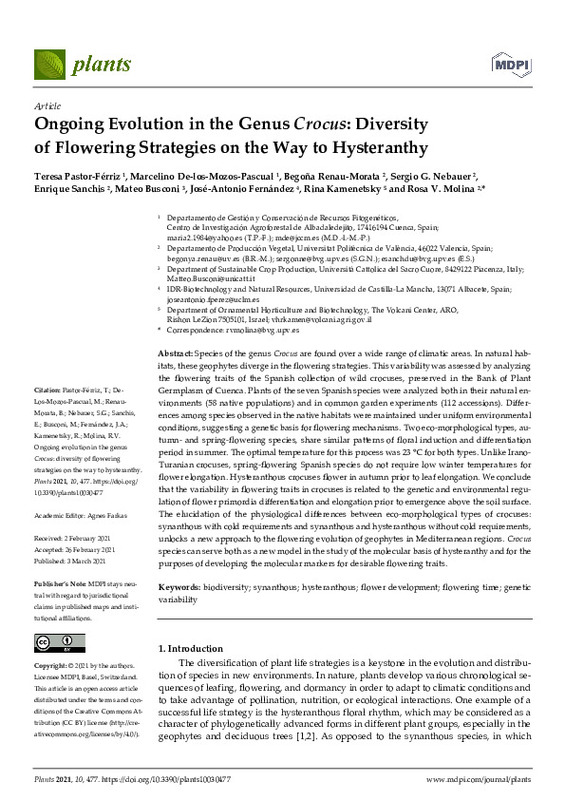JavaScript is disabled for your browser. Some features of this site may not work without it.
Buscar en RiuNet
Listar
Mi cuenta
Estadísticas
Ayuda RiuNet
Admin. UPV
Ongoing Evolution in the Genus Crocus: Diversityof Flowering Strategies on the Way to Hysteranthy
Mostrar el registro sencillo del ítem
Ficheros en el ítem
| dc.contributor.author | Pastor-Férriz, Teresa
|
es_ES |
| dc.contributor.author | De-los-Mozos-Pascual, Marcelino
|
es_ES |
| dc.contributor.author | Renau-Morata, Begoña
|
es_ES |
| dc.contributor.author | Nebauer, Sergio G.
|
es_ES |
| dc.contributor.author | Sanchís, Enrique
|
es_ES |
| dc.contributor.author | Busconi, Matteo
|
es_ES |
| dc.contributor.author | Fernández, José-Antonio
|
es_ES |
| dc.contributor.author | Kamenetsky, Rina
|
es_ES |
| dc.contributor.author | Molina Romero, Rosa Victoria
|
es_ES |
| dc.date.accessioned | 2022-10-10T18:08:06Z | |
| dc.date.available | 2022-10-10T18:08:06Z | |
| dc.date.issued | 2021-03 | es_ES |
| dc.identifier.uri | http://hdl.handle.net/10251/187402 | |
| dc.description.abstract | [EN] Species of the genus Crocus are found over a wide range of climatic areas. In natural habitats, these geophytes diverge in the flowering strategies. This variability was assessed by analyzing the flowering traits of the Spanish collection of wild crocuses, preserved in the Bank of Plant Germplasm of Cuenca. Plants of the seven Spanish species were analyzed both in their natural environments (58 native populations) and in common garden experiments (112 accessions). Differences among species observed in the native habitats were maintained under uniform environmental conditions, suggesting a genetic basis for flowering mechanisms. Two eco-morphological types, autumn- and spring-flowering species, share similar patterns of floral induction and differentiation period in summer. The optimal temperature for this process was 23 degrees C for both types. Unlike Irano-Turanian crocuses, spring-flowering Spanish species do not require low winter temperatures for flower elongation. Hysteranthous crocuses flower in autumn prior to leaf elongation. We conclude that the variability in flowering traits in crocuses is related to the genetic and environmental regulation of flower primordia differentiation and elongation prior to emergence above the soil surface. The elucidation of the physiological differences between eco-morphological types of crocuses: synanthous with cold requirements and synanthous and hysteranthous without cold requirements, unlocks a new approach to the flowering evolution of geophytes in Mediterranean regions. Crocus species can serve both as a new model in the study of the molecular basis of hysteranthy and for the purposes of developing the molecular markers for desirable flowering traits. | es_ES |
| dc.description.sponsorship | The collection activities of plant materials included in this study were mainly supported by successive Spanish research projects funded by the "Instituto Nacional de Investigacion y Tecnologia Agraria y Alimentaria" [INIA RF2004-00032-C03, INIA RF2008-00012-C03, INIA RF2011-00005-C03], co-funded by the European Regional Development Fund (ERDF-FEDER), and also by means of the European Action 018 Agri Gen Res (CrocusBank). The activities of PhD. TPF were supported by a pre-doctoral grant from the "Instituto Nacional de Investigacion y Tecnologia Agraria y Alimentaria" within the framework of the project INIA RF2011-0005-C03-01. The preservation of these materials in the facilities of the Bank of Plant Germplasm of Cuenca (CIAF Albaladejito -IRIAF), as part of the Spanish Germplasm Collection of Saffron and other Crocus, is currently supported by the Spanish National Program for Conservation and Utilization of Plant Genetic Resources for Agriculture and Food (action INIA RFP2014-00012). Some activities have been also funded by the "Ministerio de Ciencia, Innovacion y Universidades de Espana" [AGL2016-77078-R]. | es_ES |
| dc.language | Inglés | es_ES |
| dc.publisher | MDPI | es_ES |
| dc.relation.ispartof | Plants | es_ES |
| dc.rights | Reconocimiento (by) | es_ES |
| dc.subject | Biodiversity | es_ES |
| dc.subject | Synanthous | es_ES |
| dc.subject | Hysteranthous | es_ES |
| dc.subject | Flower development | es_ES |
| dc.subject | Flowering time | es_ES |
| dc.subject | Genetic variability | es_ES |
| dc.subject.classification | FISIOLOGIA VEGETAL | es_ES |
| dc.title | Ongoing Evolution in the Genus Crocus: Diversityof Flowering Strategies on the Way to Hysteranthy | es_ES |
| dc.type | Artículo | es_ES |
| dc.identifier.doi | 10.3390/plants10030477 | es_ES |
| dc.relation.projectID | info:eu-repo/grantAgreement/INIA//RF2008-00012-C03/ | es_ES |
| dc.relation.projectID | info:eu-repo/grantAgreement/INIA//RF2011-00005-C03/ | es_ES |
| dc.relation.projectID | info:eu-repo/grantAgreement/INIA//RFP2014-00012/ | es_ES |
| dc.relation.projectID | info:eu-repo/grantAgreement/MICYT//RF2004-00032-C03-03//PROSPECCION Y RECOLECCION DE GERMOPLASMA DE CROCUS EN ESPAÑA ORIENTAL Y ELABORACION DE UNA LISTA DE DESCRIPTORES PARA LA CARACTERIZACION DEL GENERO/ | es_ES |
| dc.relation.projectID | info:eu-repo/grantAgreement/AEI//AGL2016-77078-R//CONTROL DE LA FLORACION Y OPTIMIZACION DE LA NUTRICION PARA LA PRODUCCION DE AZAFRAN EN CULTIVO FORZADO EN INVERNADERO/ | es_ES |
| dc.rights.accessRights | Abierto | es_ES |
| dc.contributor.affiliation | Universitat Politècnica de València. Departamento de Producción Vegetal - Departament de Producció Vegetal | es_ES |
| dc.description.bibliographicCitation | Pastor-Férriz, T.; De-Los-Mozos-Pascual, M.; Renau-Morata, B.; Nebauer, SG.; Sanchís, E.; Busconi, M.; Fernández, J.... (2021). Ongoing Evolution in the Genus Crocus: Diversityof Flowering Strategies on the Way to Hysteranthy. Plants. 10(3):1-18. https://doi.org/10.3390/plants10030477 | es_ES |
| dc.description.accrualMethod | S | es_ES |
| dc.relation.publisherversion | https://doi.org/10.3390/plants10030477 | es_ES |
| dc.description.upvformatpinicio | 1 | es_ES |
| dc.description.upvformatpfin | 18 | es_ES |
| dc.type.version | info:eu-repo/semantics/publishedVersion | es_ES |
| dc.description.volume | 10 | es_ES |
| dc.description.issue | 3 | es_ES |
| dc.identifier.eissn | 2223-7747 | es_ES |
| dc.identifier.pmid | 33802494 | es_ES |
| dc.identifier.pmcid | PMC7999489 | es_ES |
| dc.relation.pasarela | S\430490 | es_ES |
| dc.contributor.funder | European Regional Development Fund | es_ES |
| dc.contributor.funder | Ministerio de Ciencia y Tecnología | es_ES |
| dc.contributor.funder | Universitat Politècnica de València | es_ES |
| dc.contributor.funder | Instituto Nacional de Investigación y Tecnología Agraria y Alimentaria | es_ES |
| dc.subject.ods | 15.- Proteger, restaurar y promover la utilización sostenible de los ecosistemas terrestres, gestionar de manera sostenible los bosques, combatir la desertificación y detener y revertir la degradación de la tierra, y frenar la pérdida de diversidad biológica | es_ES |
| upv.costeAPC | 1807 | es_ES |








